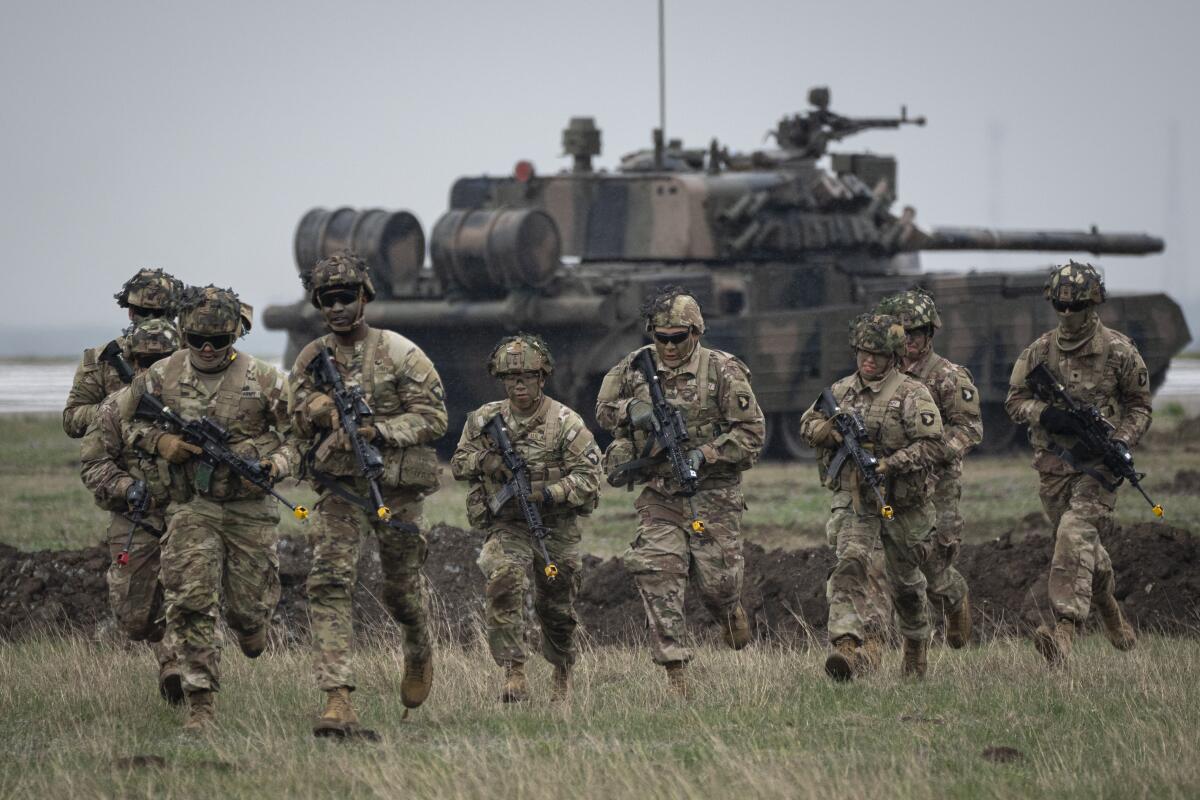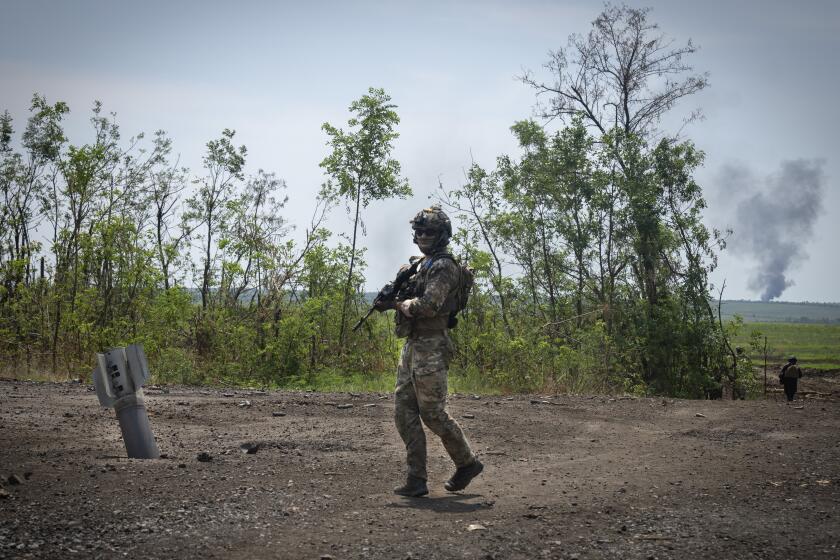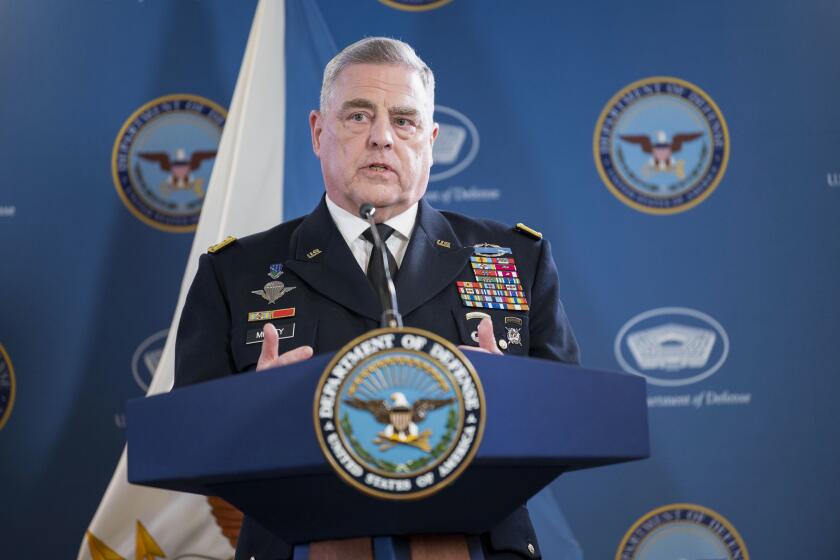NATO readies plans to defend itself against a bruised but unbowed Russia

BRUSSELS — Russia’s armed forces are bruised but by no means beaten in the war in Ukraine, a top NATO military officer said Monday, as he laid out the biggest revamp of the organization’s military plans since the Cold War in case Moscow dares to widen the conflict.
“They might not be 11 feet tall, but they are certainly not 2 feet tall,” the chairman of NATO’s Military Committee, Dutch Adm. Rob Bauer, told reporters. “So we should never underestimate the Russians and their ability to bounce back.”
President Biden and his NATO counterparts are set to endorse a major shakeup of the alliance’s planning system at a summit in the Lithuanian capital, Vilnius, next week.
NATO, as an organization, does not provide weapons or ammunition to Ukraine. It’s sought to avoid being dragged into a wider war with nuclear-armed Russia. At the same time, it is massively reinforcing the security of member countries near Russia, Ukraine and Belarus.
Around 40,000 troops are on standby from Estonia in the north down to Romania on the Black Sea. About 100 aircraft take to the skies in that territory each day, and a total of 27 warships are operating in the Baltic and Mediterranean seas. Those numbers are set to rise.
Under its new plans, NATO aims to have up to 300,000 troops ready to move to its eastern flank within 30 days. The plans divide its territory into three zones: the high north and Atlantic area, a zone north of the Alps and one in Southern Europe.
Even far from Ukraine’s front lines, military funerals set off waves of mourning. ‘You can’t see an end to it,’ one chaplain says as the war drags on.
Bauer said that NATO’s new planning is based on the strength of the Russian army before President Vladimir Putin launched the war on Ukraine more than 16 months ago. He said the war has depleted Russia’s army, but not its navy or air force.
Of Russia’s ground forces, around “94% is now engaged in the war in Ukraine,” Bauer said.
“What we see in general is that the Russians are careful around NATO. They are not for seeking a conflict with NATO. I think that is a sign that they are very, very busy,” he said. “In the land domain, I don’t think they have a lot of forces available to do anything to anyone else.
“But we are convinced that the Russians are going to reconstitute,” he said. “We will continue to look at them as a serious threat, in the maritime [arena] and in the air especially. And in space, they are still very, very capable, let alone of course in nuclear.”
Ukrainian forces are attempting to wear down the Russian army and reshape battle lines to create more favorable conditions for a counteroffensive.
A revolt by Wagner Group mercenaries in Russia late last month raised deep security concerns in Estonia, Latvia, Lithuania and Poland after a deal was reached for their leader, Yevgeny Prigozhin, to be allowed to take refuge in Belarus.
Lithuanian President Gitanas Nauseda said that neighboring countries would face a heightened danger if Wagner deploys its “serial killers” just over their border.
Vilnius lies around 22 miles from the Belarus border.
Lithuania wants to have a permanent NATO presence on its territory. Germany signaled last week that it would be prepared to base soldiers there if requested. For the moment, though, NATO sees no imminent threat coming from Belarus.
Start your day right
Sign up for Essential California for the L.A. Times biggest news, features and recommendations in your inbox six days a week.
You may occasionally receive promotional content from the Los Angeles Times.
“We’re confident we know what’s going on, and right now we see no changes. But that doesn’t take our eye off what we need to do every day,” U.S. Major Gen. Matthew Van Wagenen told reporters. “If we needed to change posture, we could do it rapidly.”
NATO’s 31 member countries took part in a “force generation conference” last week in an effort to understand how many troops and how much equipment the alliance might have at its disposal to respond to any Russian attack, both in the short and longer terms.
Both Bauer and Van Wagenen were upbeat about the results, although they declined to provide details for security reasons. Experts and some NATO diplomats, however, have expressed doubt about the willingness of member countries to put a total of 300,000 troops on standby.
“I would classify it as highly successful,” Van Wagenen said. “I can assure you, we are in a position right now that we know what’s missing and how we need to grow this in the future.”
The top American military officer says the U.S. is considering providing cluster munitions to Ukraine.
In terms of NATO’s ability to execute the plans, should they be needed in the future, Bauer welcomed the expected commitment in Vilnius by Biden and his counterparts to boost defense spending, which should help provide commanders with the equipment they need.
In 2014, NATO nations committed to move toward spending 2% of GDP on their military budgets by 2024. At their July 11-12 summit, the leaders will set the 2% figure as a spending floor, rather than a ceiling to aim for.
More to Read
Sign up for Essential California
The most important California stories and recommendations in your inbox every morning.
You may occasionally receive promotional content from the Los Angeles Times.













